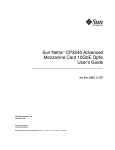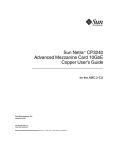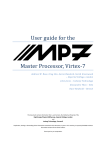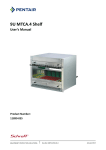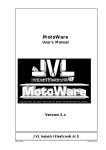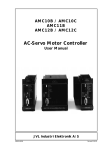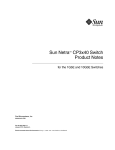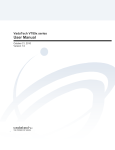Download Sun Netra CP3240 Advanced Mezzanine Card LED Userճ Guide
Transcript
Sun Netra™ CP3240 Advanced Mezzanine Card LED User’s Guide for the AMC.0-LED Sun Microsystems, Inc. www.sun.com Part No. 820-7263-10 April 2009, Revision 01 Submit comments about this document at: http://www.sun.com/hwdocs/feedback Copyright © 2009 Sun Microsystems, Inc., 4150 Network Circle, Santa Clara, California 95054, U.S.A. All rights reserved. Sun Microsystems, Inc. has intellectual property rights relating to technology embodied in the product that is described in this document. In particular, and without limitation, these intellectual property rights may include one or more of the U.S. patents listed at http://www.sun.com/patents and one or more additional patents or pending patent applications in the U.S. and in other countries. This distribution may include materials developed by third parties. Parts of the product may be derived from Berkeley BSD systems, licensed from the University of California. UNIX is a registered trademark in the U.S. and in other countries, exclusively licensed through X/Open Company, Ltd. Sun, Sun Microsystems, the Sun logo, Solaris, Netra and the Netra logo are trademarks or registered trademarks of Sun Microsystems, Inc., or its subsidiaries, in the U.S. and other countries. Products covered by and information contained in this service manual are controlled by U.S. Export Control laws and may be subject to the export or import laws in other countries. Nuclear, missile, chemical biological weapons or nuclear maritime end uses or end users, whether direct or indirect, are strictly prohibited. Export or reexport to countries subject to U.S. embargo or to entities identified on U.S. export exclusion lists, including, but not limited to, the denied persons and specially designated nationals lists is strictly prohibited. Use of any spare or replacement CPUs is limited to repair or one-for-one replacement of CPUs in products exported in compliance with U.S. export laws. Use of CPUs as product upgrades unless authorized by the U.S. Government is strictly prohibited. DOCUMENTATION IS PROVIDED "AS IS" AND ALL EXPRESS OR IMPLIED CONDITIONS, REPRESENTATIONS AND WARRANTIES, INCLUDING ANY IMPLIED WARRANTY OF MERCHANTABILITY, FITNESS FOR A PARTICULAR PURPOSE OR NON-INFRINGEMENT, ARE DISCLAIMED, EXCEPT TO THE EXTENT THAT SUCH DISCLAIMERS ARE HELD TO BE LEGALLY INVALID. Copyright © 2009 Sun Microsystems, Inc., 4150 Network Circle, Santa Clara, California 95054, Etats-Unis. Tous droits réservés. Sun Microsystems, Inc. détient les droits de propriété intellectuels relatifs à la technologie incorporée dans le produit qui est décrit dans ce document. En particulier, et ce sans limitation, ces droits de propriété intellectuelle peuvent inclure un ou plus des brevets américains listés à l’adresse http://www.sun.com/patents et un ou les brevets supplémentaires ou les applications de brevet en attente aux Etats - Unis et dans les autres pays. Cette distribution peut comprendre des composants développés par des tierces parties. Des parties de ce produit pourront être dérivées des systèmes Berkeley BSD licenciés par l’Université de Californie. UNIX est une marque déposée aux Etats-Unis et dans d’autres pays et licenciée exclusivement par X/Open Company, Ltd. Sun, Sun Microsystems, le logo Sun, Solaris, Netra et le logo Netra sont des marques de fabrique ou des marques déposées de Sun Microsystems, Inc., ou ses filiales, aux Etats-Unis et dans d’autres pays. Ce produit est soumis à la législation américaine en matière de contrôle des exportations et peut être soumis à la règlementation en vigueur dans d’autres pays dans le domaine des exportations et importations. Les utilisations , ou utilisateurs finaux, pour des armes nucléaires, des missiles, des armes biologiques et chimiques ou du nucléaire maritime, directement ou indirectement, sont strictement interdites. Les exportations ou reexportations vers les pays sous embargo américain, ou vers des entités figurant sur les listes d’exclusion d’exportation américaines, y compris, mais de manière non exhaustive, la liste de personnes qui font objet d’un ordre de ne pas participer, d’une façon directe ou indirecte, aux exportations des produits ou des services qui sont régis par la législation américaine en matière de contrôle des exportations et la liste de ressortissants spécifiquement désignés, sont rigoureusement interdites. L’utilisation de pièces détachées ou d’unités centrales de remplacement est limitée aux réparations ou à l’échange standard d’unités centrales pour les produits exportés, conformément à la législation américaine en matière d’exportation. Sauf autorisation par les autorités des Etats-Unis, l’utilisation d’unités centrales pour procéder à des mises à jour de produits est rigoureusement interdite. LA DOCUMENTATION EST FOURNIE "EN L’ETAT" ET TOUTES AUTRES CONDITIONS, DECLARATIONS ET GARANTIES EXPRESSES OU TACITES SONT FORMELLEMENT EXCLUES, DANS LA MESURE AUTORISEE PAR LA LOI APPLICABLE, Y COMPRIS NOTAMMENT TOUTE GARANTIE IMPLICITE RELATIVE A LA QUALITE MARCHANDE, A L’APTITUDE A UNE UTILISATION PARTICULIERE OU A L’ABSENCE DE CONTREFACON. Please Recycle Contents Preface xi Before You Read This Document xi How This Document Is Organized Typographic Conventions Related Documentation Third-Party Web Sites xiii xiv xv Sun Welcomes Your Comments 1. Getting Started 1.1 xii xv 1–1 System Requirements 1–2 1.1.1 Connectivity 1–2 1.1.2 Electrical and Environmental 1.1.3 Disposal 1.1.4 Connectors 1.1.5 Jumper Options 1–2 1–2 1–3 1–3 1.2 Unpacking 1–3 1.3 Handling AMC.0-LEDs 1.4 AMC.0-LED Faceplate 1.5 LEDs 1.6 Removing and Installing AMC.0-LEDs 1–4 1–5 1–6 1–8 iii 2. 3. Removing an AMC.0-LED 1.6.2 Removing a Switch and AMC.0-LED 1.6.3 Installing an AMC.0-LED Overview Features 2.2 Key Components 1–13 2–2 2.2.1 Lattice MachXO 2.2.2 Port LEDs 2–2 2.2.3 Push Button for Base or Fabric LEDs 2.2.4 Pigeon Point BMR-AVR-AMCm AdvancedMC IPMI Subsystem 2–3 2–2 AMC.0-LED Functional Block 2.4 AMC.0-LED Port Map 2.5 Technical Support and Warranty Configuring Jumper Settings Managing the AMC.0-LED 4.1 IPMI Firmware 4.2 IPMI Sensors 2–4 2–5 2–5 3–1 Jumper Locations and Settings 3–2 4–1 4–2 4–2 A. Environment Specifications A–1 Electrical and Environmental A–2 A.1.1 Absolute Maximum Ratings A.1.2 Normal Operating Ranges A.2 Reliability A.3 Mechanical B. Connectors iv 1–11 2–2 2.3 A.1 1–8 2–1 2.1 3.1 4. 1.6.1 A–2 A–2 A–3 A–3 B–1 Sun Netra CP3240 Advanced Mezzanine Card LED User’s Guide • April 2009 2–3 B.1 Connector Locations and Assignments B.2 Connector Pinouts B.2.1 B.3 B–3 Goldfingers (GF1) Connectors OEM Connector (J1) C. Agency Certifications B–3 B–6 C–1 C.1 CE Certification C.2 NEBS/ETSI C.3 Safety C.4 Emissions Test Regulations C.5 B–2 C–2 C–2 C–2 C–3 C.4.1 EN 55022 Emissions C–3 C.4.2 EN 55024 Immunity C–4 Regulatory Information C–5 C.5.1 FCC (USA) C–5 C.5.2 Industry Canada (Canada) C–5 Contents v vi Sun Netra CP3240 Advanced Mezzanine Card LED User’s Guide • April 2009 Figures FIGURE 1-1 AMC.0-LED Faceplate 1–5 FIGURE 1-2 Deactivating the AMC.0-LED FIGURE 1-3 Removing the AMC.0-LED FIGURE 1-4 Front Cable Management Bracket in Lower Position FIGURE 1-5 Injector/Ejector on the Netra CP3240 switch (Open Position) FIGURE 1-6 Opening the Injector/Ejector Latches FIGURE 1-7 Inserting the AMC FIGURE 2-1 AMC.0-LED Functional Block Diagram FIGURE 3-1 AMC.0-LED Jumper Locations 3–2 FIGURE A-1 AMC.0-LED PCB Dimensions A–4 FIGURE B-1 AMC.0-LED Connector Locations 1–9 1–10 1–11 1–12 1–14 1–16 2–4 B–2 vii viii Sun Netra CP3240 Advanced Mezzanine Card LED User’s Guide • April 2009 Tables TABLE 1-1 ATCA Board Status LEDs 1–6 TABLE 1-2 Hot-Swap LED States 1–7 TABLE 2-1 AMC.0-LED Port Map TABLE 3-1 AMC.0-LED Configuration Jumper Settings TABLE 4-1 State Sensor TABLE 4-2 Threshold Sensors TABLE A-1 Absolute Maximum Electrical and Temperature Ratings TABLE A-2 Normal Operating Electrical and Temperature Ratings TABLE A-3 Board Dimensions and Weight TABLE B-1 AMC.0-LED Connector Assignments TABLE B-2 AMC.0-LED Goldfingers (GF1) Connectors 2–5 3–2 4–2 4–2 A–2 A–2 A–3 B–2 B–3 ix x Sun Netra CP3240 Advanced Mezzanine Card LED User’s Guide • April 2009 Preface The Sun Netra™ CP3240 Advanced Mezzanine Card LED User’s Guide describes the installation and configuration of the Sun Netra CP3240 AMC.0-LED (AMC.0-LED). This guide also includes information about software, environment specifications, connectors, and certifications. Before You Read This Document Obtain and read the following documents: ■ Sun Netra CP3x40 Switch Safety and Compliance Manual (820-3505) ■ Sun Netra CP3x40 Switch Product Notes (820-3260) ■ Sun Netra CP3240 Switch Installation Guide (820-3251) xi How This Document Is Organized Chapter 1 provides unpacking instructions and initial setup information for the AMC.0-LED. It provides information and procedures needed to install and make the Sun Netra CP3240 AMC.0-LED operational. Chapter 2 introduces the key features of the AMC.0-LED. This chapter includes a product definition, a list of product features, and a functional block diagram with a brief description of each block. This chapter can be used to compare the features of the AMC.0-LED against the needs of a specific application. Chapter 3 describes the jumper settings on the AMC.0-LED. This chapter details factory default settings and provides information about tailoring the AMC.0-LED to the needs of specific applications. Chapter 4 describes the management software running on the AMC.0-LED. This section serves as a primer for using the software to manage the AMC.0-LED. Appendix A contains the electrical, environmental, and mechanical specifications for the AMC.0-LED. Appendix B provides a connector location illustration and connector pin out tables. A detailed description and pin out for each connector is given. Appendix C presents UL, CE, and FCC agency approval and certification information for the AMC.0-LED. xii Sun Netra CP3240 Advanced Mezzanine Card LED User’s Guide • April 2009 Typographic Conventions Typeface Meaning Examples AaBbCc123 The names of commands, files, and directories; on-screen computer output Edit your.login file. Use ls -a to list all files. % You have mail. AaBbCc123 What you type, when contrasted with on-screen computer output % su Password: AaBbCc123 Book titles, new words or terms, words to be emphasized. Replace command-line variables with real names or values. Read Chapter 6 in the User’s Guide. These are called class options. You must be superuser to do this. To delete a file, type rm filename. Note – Characters display differently depending on browser settings. If characters do not display correctly, change the character encoding in your browser to Unicode UTF-8. Preface xiii Related Documentation The following table lists the documentation for the AMC.0-LED and its corresponding switch. The online documentation is available at: http://docs.sun.com/app/docs/prod/cp3240.led#hic http://docs.sun.com/app/docs/prod/cp3240.switch?l=en#hic Application Title Part Number Format Location Latest information Sun Netra CP3240 Advanced Mezzanine Card Product Notes 820-7575-xx PDF Online Latest information Sun Netra CP3x40 Switch Product Notes 820-3260-xx PDF Online Pointer doc Sun Netra CP3240 Advanced Mezzanine Card LED Getting Started Guide 820-7260-xx Printed Shipping Kit Installation (this document) Sun Netra CP3240 Advanced Mezzanine Card LED User’s Guide 820-7263-xx PDF Online Usage Sun Netra CP3240 Switch User’s Guide 820-3252-xx PDF Online Reference Sun Netra CP3240 Switch Software Reference Manual 820-3253-xx PDF Online Safety Sun Netra CP3x40 Switch Safety and Compliance Manual 820-3505-xx PDF Online The following table lists the documentation that is related to this product. The online documentation is available at: http://docs.sun.com/app/docs/prod/n900.srvr#hic . Application Title Part Number Format Location Latest information Netra CT 900 Server Product Notes 819-1180-xx PDF Online Pointer doc Netra CT 900 Server Getting Started Guide 819-1173-xx Printed Shipping kit Overview Netra CT 900 Server Overview 819-1174-xx PDF Online Installation Netra CT 900 Server Installation Guide 819-1175-xx PDF Online Service Netra CT 900 Server Service Manual 819-1176-xx PDF Online Administration Netra CT 900 Server Administration and Reference Manual 819-1177-xx PDF Online xiv Sun Netra CP3240 Advanced Mezzanine Card LED User’s Guide • April 2009 Application Title Part Number Format Location Programming Netra CT 900 Software Developer’s Guide 819-1178-xx PDF Online Safety Netra CT 900 Server Safety and Compliance Guide 819-1179-xx PDF Online Setup Netra CT 900 Server Hardware Setup Guide 819-1647-xx PDF Online Safety Important Safety Information for Sun Hardware Systems 816-7190-xx Printed Shipping kit Third-Party Web Sites Sun is not responsible for the availability of third-party web sites mentioned in this document. Sun does not endorse and is not responsible or liable for any content, advertising, products, or other materials that are available on or through such sites or resources. Sun will not be responsible or liable for any actual or alleged damage or loss caused by or in connection with the use of or reliance on any such content, goods, or services that are available on or through such sites or resources. Sun Welcomes Your Comments Sun is interested in improving its documentation and welcomes your comments and suggestions. You can submit your comments by going to: http://www.sun.com/hwdocs/feedback Please include the title and part number of your document with your feedback: Sun Netra CP3240 Advanced Mezzanine Card LED User’s Guide, part number 820-726310. Preface xv xvi Sun Netra CP3240 Advanced Mezzanine Card LED User’s Guide • April 2009 CHAPTER 1 Getting Started This chapter provides information and procedures to install and make the Sun Netra CP3240 AMC.0-LED operational. Read this chapter before using the AMC.0-LED. In addition to this chapter, refer to the following safety documentation: ■ Sun Netra CP3x40 Switch Safety and Compliance Manual (820-3505) ■ Important Safety Information for Sun Hardware Systems (816-7190) Caution – When the system is plugged in, energy hazards are present on the midplane. Do not reach into the enclosure while the power is on. Caution – Static electricity can damage electronic components. Wear a wrist strap grounded through one of the system’s ESD ground jacks when removing and replacing hot-swappable components. This chapter contains the following topics: ■ Section 1.1, “System Requirements” on page 1-2 ■ Section 1.2, “Unpacking” on page 1-3 ■ Section 1.3, “Handling AMC.0-LEDs” on page 1-4 ■ Section 1.4, “AMC.0-LED Faceplate” on page 1-5 ■ Section 1.5, “LEDs” on page 1-6 ■ Section 1.6, “Removing and Installing AMC.0-LEDs” on page 1-8 1-1 1.1 System Requirements The following sections briefly describe the minimum system requirements and the configurable features. Links are provided to other chapters and appendices containing more detailed information. 1.1.1 Connectivity The Sun Netra CP3240 AMC.0-LED is designed to be used with the Netra CP3240 switch. It can be used in any available AMC site on the Netra CP3240 switch. Note – The Sun Netra CP3240 AMC.0-LED will not work in any other product. 1.1.2 Electrical and Environmental The AMC.0-LED has a 10W power requirement and does not require any air flow for cooling. See Appendix A for detailed electrical and environmental requirements. 1.1.3 Disposal The AMC.0-LED might contain materials that require regulation upon disposal. Please dispose of this product in accordance with local rules and regulations. For disposal or recycling information, please contact your local authorities or the Electronic Industries Alliance at http://www.eiae.org/. 1-2 Sun Netra CP3240 Advanced Mezzanine Card LED User’s Guide • April 2009 1.1.4 Connectors The AMC.0-LED includes goldfinger connectors to interface with the host board. Refer to the Appendix B for complete connector descriptions and pinouts. 1.1.5 Jumper Options The AMC.0-LED provides several jumper configuration options for features. By default all jumpers are off. Jumper locations and descriptions are provided in Chapter 3. 1.2 Unpacking Check the shipping carton for damage. If the shipping carton or contents are damaged, notify the carrier and Sun. Retain the shipping carton and packing material for inspection by the carrier. Obtain authorization before returning any product to Sun. Refer to the Sun Netra CP3240 Advanced Mezzanine Card Getting Started Guide (820-7260) for return instructions. Caution – This board must be protected from static discharge and physical shock. Never remove any of the socketed parts except at a static-free workstation. Use the antistatic bag shipped with the product to handle the board. Wear a wrist strap grounded through one of the system's ESD ground jacks when installing or servicing system components. Chapter 1 Getting Started 1-3 1.3 Handling AMC.0-LEDs Caution – The system is sensitive to static electricity. To prevent damage to the assembly, always connect an antistatic wrist strap between you and the system. Caution – Do not flex the AMC.0-LEDs; the surface-mounted components can break if the AMC.0-LED is bent. To minimize the amount of AMC.0-LED flexing, observe the following precautions: 1-4 ■ When removing a AMC.0-LED from an electrostatic discharge bag, keep it vertical until you place the AMC.0-LED on the electrostatic discharge mat. ■ Do not place a AMC.0-LED on a hard surface. Use a cushioned antistatic mat. The AMC.0-LED connectors and components have very thin pins that bend easily. ■ Be careful of small parts located on the component side of a AMC.0-LED. ■ Do not use an oscilloscope probe on the components. The soldered pins are easily damaged or shorted by the probe point. ■ Transport a AMC.0-LED in an antistatic bag. Sun Netra CP3240 Advanced Mezzanine Card LED User’s Guide • April 2009 1.4 AMC.0-LED Faceplate The following shows the faceplate of the Sun Netra CP3240 AMC.0-LED. This AMC.0-LED must be paired with a Netra CP3240 switch. FIGURE 1-1 AMC.0-LED Faceplate Chapter 1 Getting Started 1-5 1.5 LEDs The tables in this section give status information for the LEDs on the AMC.0-LED. The following table describes the LEDs defined by ATCA to monitor board status. TABLE 1-1 ATCA Board Status LEDs LED Color Normal Operation Description OOS Red Off Out of service. This LED lights on a critical AMC.0-LED error, indicating that the board should be removed. OK Green On This LED is lit when the AMC.0-LED is booted and switching. A Amber Off Minor Error/User Defined. This LED can be customized using software applications. Note that the OOS LED will be lit when the board is powered yet not booted. This includes all hot-swap states M1 through M3. It will remain on until the IPMI software has received the E-Keying signal from the shelf manager. 1-6 Sun Netra CP3240 Advanced Mezzanine Card LED User’s Guide • April 2009 The following table shows the different states of the Hot-Swap LED. TABLE 1-2 Hot-Swap LED States Order Visible State State Description 1 Solid M1 FRU Inactive The Intelligent Platform Management Interface (IPMI) microcontroller is booted, but the payload is not. The bottom latch is not fully closed. 2 Blinking (from solid) M2 Activation Request The IPMI microcontroller has requested permission to boot the payload from the shelf management controller. 3 Off M3-M4 Active The IPMI microcontroller has received permission to boot the payload, and has done so. This should be the state under normal operation. 4 Blinking (from off) M5-M6 Deactivation Request The IPMI microcontroller has requested permission to shut down the payload. Opening the bottom latch activates this state. Note – A board should be hot-swapped only when the LED is solid blue. Chapter 1 Getting Started 1-7 1.6 Removing and Installing AMC.0-LEDs This section describes how to remove and install AMC.0-LEDs. 1.6.1 Removing an AMC.0-LED If you want to remove only an AMC.0-LED from a Netra CP3240 switch, use the following instructions. If you want to remove the switch with the AMC.0-LED installed, see Section 1.6.2, “Removing a Switch and AMC.0-LED” on page 1-11. 1. Shut down the payload OS. If you fail to do this before pulling the AMC.0-LED’s hotswap latch, the OS might panic. 2. At the front of the Netra CP3240 switch, locate the AMC.0-LED you want to remove. 3. Initiate the hot-swap deactivation sequence by pulling the injector/ejector latch out half way (FIGURE 1-2). The Hot-Swap LED starts blinking. Wait until the LED is solid blue. 4. When the hot-swap LED is solid blue, pull the injector/ejector latch out completely (FIGURE 1-2). 1-8 Sun Netra CP3240 Advanced Mezzanine Card LED User’s Guide • April 2009 FIGURE 1-2 Deactivating the AMC.0-LED Figure Legend 1 Fully In (IN) When IN, the module communicates to the Shelf Manager that the module is not in the Hotswap state, and the Shelf Manager communicates with the MMC. This position is for normal operation. 2 Half Way (HW) When in the HW position, the hotswap sequence is initiated. The MMC sends a hotswap event to the Shelf Manager. 3 Out (OUT) When OUT, the latching mechanism is released and the module can be extracted. Wait for the Hot-Swap LED to stop blinking before pulling the latch all the way out. Chapter 1 Getting Started 1-9 5. Remove the AMC.0-LED as shown in the following figure. FIGURE 1-3 Removing the AMC.0-LED Caution – Failure to fill all sites with AMC.0-LEDs or cover with filler panels can negatively impact the cooling of the system. 6. Replace the AMC.0-LED with another AMC.0-LED (FIGURE 1-7) or a filler panel. 1-10 Sun Netra CP3240 Advanced Mezzanine Card LED User’s Guide • April 2009 Note – Be sure to follow handling instructions. See Section 1.3, “Handling AMC.0-LEDs” on page 1-4. 1.6.2 Removing a Switch and AMC.0-LED Following are the instructions for removing both a Netra CP3240 switch and an installed AMC.0-LED. For instructions on removing switch and RTM sets, refer to the Sun Netra CP3240 Switch Installation Guide (820-3251). 1. Move the front cable management bracket to the lower position (FIGURE 1-4). FIGURE 1-4 Front Cable Management Bracket in Lower Position 2. Disengage the injector/ejector mechanisms at the top and bottom of the switch to notify software that the board is about to be removed. 3. Wait for the Hot-Swap LED to light. Chapter 1 Getting Started 1-11 FIGURE 1-5 Injector/Ejector on the Netra CP3240 switch (Open Position) injector/ejector mechanism 4. Disconnect all cables connected to the switch. 5. Loosen the two board retention screws that fasten the board to the enclosure. 6. Open the ejectors fully, rotating the handles outward until the board disengages from the midplane. 7. Slide the board evenly out of the enclosure. Caution – Failure to cover all open sites with filler panels can negatively impact the cooling of the system. 8. Either replace the switch or install a filler panel: 1-12 ■ If you are going to replace the switch, refer to the Sun Netra CP3240 Switch Installation Guide (820-3251) for instructions. ■ If you are not going to replace the switch, install a filler panel to maintain the shielding and cooling performance of the enclosure. Sun Netra CP3240 Advanced Mezzanine Card LED User’s Guide • April 2009 Note – When a switch is removed from the site, and the system is running with only a single remaining switch, you do not have redundancy for that component. Both switches must be installed and running to have redundancy for that component. 1.6.3 Installing an AMC.0-LED Following are the instructions for installing an AMC.0-LED. For instructions on installing switch and RTM sets, refer to the Sun Netra CP3240 Switch Installation Guide (820-3251). 1. At the front of the Netra CP3240 switch, locate the AMC site where you want to install the AMC.0-LED. 2. Remove the filler panel, if necessary. 3. Obtain the AMC.0-LED card from the ship kit. Note – Follow unpacking and handling instructions in Section 1.2, “Unpacking” on page 1-3 and Section 1.3, “Handling AMC.0-LEDs” on page 1-4. 4. Perform any card-specific hardware procedures, if necessary. 5. Prepare the AMC.0-LED by opening its injector/ejector latches. Chapter 1 Getting Started 1-13 FIGURE 1-6 Opening the Injector/Ejector Latches Figure Legend 1 Fully In (IN) When IN, the module communicates to the Shelf Manager that the module is not in the Hotswap state, and the Shelf Manager communicates with the MMC. This position is for normal operation. 2 Half Way (HW) When in the HW position, the hotswap sequence is initiated. The MMC sends a hotswap event to the Shelf Manager. 3 1-14 Out (OUT) When OUT, the latching mechanism is released and the module can be extracted. Wait for the Hot-Swap LED to stop blinking before pulling the latch all the way out. Sun Netra CP3240 Advanced Mezzanine Card LED User’s Guide • April 2009 6. Carefully align the edges of the board with the guides in the appropriate site. It might be helpful to look into the enclosure to verify correct alignment of the rails in the guides. Caution – Do not force the AMC.0-LED into the site. If it does not fit properly, check to ensure that you have the correct matching AMC.0-LED for the switch. Chapter 1 Getting Started 1-15 7. Keeping the board aligned in the guides, slide the board in by pressing on the AMC.0-LED faceplate until the AMC.0-LED faceplate is flush with the Netra CP3240 switch faceplate. FIGURE 1-7 1-16 Inserting the AMC Sun Netra CP3240 Advanced Mezzanine Card LED User’s Guide • April 2009 8. Push the ejector latch in fully. If the system power is on and the AMC.0-LED is installed properly, the AMC.0-LED board Hot-Swap LED lights up. The Hot-Swap LED blinks for several seconds, then goes off. If the Hot-Swap LED does not go off after several seconds, push firmly on the injector/ejector handles to ensure that they are pushed in all the way. Caution – Failure to fill all sites with AMC.0-LEDs or cover with filler panels can negatively impact the cooling of the system. Chapter 1 Getting Started 1-17 1-18 Sun Netra CP3240 Advanced Mezzanine Card LED User’s Guide • April 2009 CHAPTER 2 Overview This chapter introduces the key features of the AMC.0-LED. This chapter includes a product definition, a list of product features, and functional block diagrams with brief descriptions. This chapter contains the following topics: ■ Section 2.1, “Features” on page 2-2 ■ Section 2.2, “Key Components” on page 2-2 ■ Section 2.3, “AMC.0-LED Functional Block” on page 2-4 ■ Section 2.4, “AMC.0-LED Port Map” on page 2-5 ■ Section 2.5, “Technical Support and Warranty” on page 2-5 2-1 2.1 Features Part of Sun’s ATCA platform, the Sun Netra CP3240 AMC.0-LED complies with PICMG 3.0 AdvancedTCA Specification AMC.0 R2.0. The AMC.0-LED is an AMC board designed to provide the port status of Netra CP3240 switch ports via LEDs. The following briefly outlines the features of the AMC.0-LED: 2.2 ■ 27 numbered bicolor LEDs, each representing a port ■ 2 LEDs representing the current set of ports displayed (Base or Fabric) ■ A momentary push button to change between displaying Base and Fabric ports ■ Hot-swap ability and IPMI management ■ FPGA for configurable LED output ■ Support for HPM.1 compliant firmware upgrades Key Components The following sections describe key components of the Sun Netra CP3240 AMC.0-LED. 2.2.1 Lattice MachXO A Lattice MachXO is used to perform the serial-to-parallel conversion of the port status data. 2.2.2 Port LEDs Each port has one LED. The LEDs are bicolor and represent the speed, activity, and link status of the ports. For descriptions of LED ports, see Section 2.4, “AMC.0-LED Port Map” on page 2-5. 2-2 Sun Netra CP3240 Advanced Mezzanine Card LED User’s Guide • April 2009 2.2.3 Push Button for Base or Fabric LEDs Only either the Base or Fabric port LEDs are shown at one time. The Base and Fabric LEDs indicate which set of ports is currently being displayed. The push button can be pressed to switch between the Base or Fabric set of ports. 2.2.4 Pigeon Point BMR-AVR-AMCm AdvancedMC IPMI Subsystem The AMC.0-LED uses the near industry standard Pigeon Point Systems BMR-AVR-AMCm for dedicated IPMI management. It controls all interaction between the AMC.0-LED and the ATCA carrier or uTCA management controller. It fully supports the AMC.0 R2.0 specifications. The BMR-AVR-AMCm provides all required management for the AMC.0-LED modules in addition to the voltage monitoring, temperature monitoring, e-Keying, and other services it provides for the AMC.0-LED. Pigeon Point Systems is the leading provider of IPMI firmware for PICMG, and its firmware has been thoroughly tested to be fully compliant with the specification. Chapter 2 Overview 2-3 2.3 AMC.0-LED Functional Block FIGURE 2-1 2-4 AMC.0-LED Functional Block Diagram Sun Netra CP3240 Advanced Mezzanine Card LED User’s Guide • April 2009 2.4 AMC.0-LED Port Map The following table provides port mapping for the AMC.0-LED. TABLE 2-1 2.5 AMC.0-LED Port Map Port Connected Port Connected 0 FPGA 13 FPGA 1 Not Connected 14 Not Connected 2 Not Connected 15 Not Connected 3 Not Connected 17 Not Connected 4 Not Connected 18 Not Connected 5 Not Connected 19 Not Connected 6 Not Connected 20 FPGA 7 Not Connected TCLK1 Not Connected 8 Not Connected TCLK2 Not Connected 9 Not Connected TCLK3 Not Connected 10 Not Connected TCLK4 Not Connected 11 Not Connected FCLK Not Connected 12 FPGA Technical Support and Warranty Should you have any technical questions or support issues that are not addressed in the Sun Netra CP3240 AMC.0-LED documentation set or on the web site, contact your local Sun Services representative. This hardware carries a one-year return-to-depot warranty. For customers in the US or Canada, call 1-800-USA-4SUN (1-800-872-4786). For customers in the rest of the world, find the World Wide Solution Center nearest you by visiting our web site: http://www.sun.com/service/contacting/solution.html Chapter 2 Overview 2-5 When you call Sun Services, indicate if the Sun Netra CP3240 AMC.0-LED was purchased separately and is not associated with a system. Have the proper AMC identification information ready. Be prepared to give the representative the AMC part number, serial number, and date code. 2-6 Sun Netra CP3240 Advanced Mezzanine Card LED User’s Guide • April 2009 CHAPTER 3 Configuring Jumper Settings This chapter describes jumper settings for configuring the AMC.0-LED. Other configuration options are software controlled. Software configuration options are described in Chapter 4. 3-1 3.1 Jumper Locations and Settings The following figure shows the locations of the jumpers. The following table defines the settings. 3-2 FIGURE 3-1 AMC.0-LED Jumper Locations TABLE 3-1 AMC.0-LED Configuration Jumper Settings Jumper Default Purpose 1 P1 Off Connects bracket ground to digital ground, when set to On 2 P2 Reserved Reserved 3 P3 Reserved Reserved Sun Netra CP3240 Advanced Mezzanine Card LED User’s Guide • April 2009 CHAPTER 4 Managing the AMC.0-LED This chapter describes the AMC.0-LED management software. The Sun Netra CP3240 AMC.0-LED includes full IPMI support. This chapter contains the following topics: ■ Section 4.1, “IPMI Firmware” on page 4-2 ■ Section 4.2, “IPMI Sensors” on page 4-2 4-1 4.1 IPMI Firmware The IPMI firmware is a customized version of Pigeon Point Systems’ BMR-AVR-AMCm software. It provides all the standard AMC.0 R2.0 management features. For instructions on upgrading the firmware, refer to Sun Netra CP3240 AMC Product Notes (820-7575). 4.2 IPMI Sensors The following sensors are accessible through the IPMI. TABLE 4-1 State Sensor Sensor Name Type Description Discrete States Returned 0 FRU 0 HOT_SWAP State Hot swap discrete state M state, per ATCA and AMC specification TABLE 4-2 Threshold Sensors Sensor Name 0 Major Critical Upper Thresholds Minor Major Critical Description Units Hot- Hotswap swap Hot-swap M states N/A N/A N/A N/A N/A N/A 1 +3.3V Thresh STBY IPMI Mgmt Power Volts 3.1652 3.034 2.9192 3.46 3.608 3.805 2 +12V Main power Volts input 11.44 11.0 10.01 12.705 13.145 13.75 4-2 Type Lower Thresholds Minor Thresh Sun Netra CP3240 Advanced Mezzanine Card LED User’s Guide • April 2009 TABLE 4-2 Threshold Sensors Type Description Units Lower Thresholds Minor Major Critical Upper Thresholds Minor Major Critical Sensor Name 3 +3.3V Thresh Onboard Volts Voltage Reg. 3.1652 3.034 2.9192 3.4604 3.608 3.805 4 DS75 Thresh Temp (1) Ambient temp. sensor oC N/A N/A N/A 60 70 80 5 DS75 Thresh Temp (2) Ambient temp. sensor oC N/A N/A N/A 60 70 80 Chapter 4 Managing the AMC.0-LED 4-3 4-4 Sun Netra CP3240 Advanced Mezzanine Card LED User’s Guide • April 2009 APPENDIX A Environment Specifications This appendix describes the electrical, environmental, and mechanical specifications. It includes connector descriptions and pinouts, as well as illustrations of the board dimensions and connector locations. This appendix contains the following topics: ■ Section A.1, “Electrical and Environmental” on page A-2 ■ Section A.2, “Reliability” on page A-3 ■ Section A.3, “Mechanical” on page A-3 A-1 A.1 Electrical and Environmental The following sections provide tables and illustrations showing the electrical and environmental specifications. A.1.1 Absolute Maximum Ratings The following values are stress ratings only. Do not operate at these maximums. See Section A.1.2, “Normal Operating Ranges” on page A-2 for normal operating conditions. TABLE A-1 A.1.2 Absolute Maximum Electrical and Temperature Ratings Description Range Supply voltage, 12V 0 VDC to +13.2 VDC Management voltage, +3.3V 0 VDC to +5.5 VDC Storage temperature -40˚ to +85˚ Celsius Noncondensing relative humidity <95% at 40˚ Celsius Normal Operating Ranges TABLE A-2 Normal Operating Electrical and Temperature Ratings Description Range Nominal operating voltage +10.8 to +13.2 VDC payload power +2.97 to + 3.63 VDC management power Operating temperatures: • 60m below sea level up to 1800m above sea level* • from 1800m up to 4000m above sea level** -5˚ to +55˚ Celsius -5˚ to +40˚ Celsius Operating humidity <85% at 40˚ Celsius Maximum power consumption 1.5W *The MTBF will be significantly reduced if operated above 45˚C for more than 96 consecutive hours. **The MTBF will be significantly reduced if operated above 30˚C for more than 96 consecutive hours. A-2 Sun Netra CP3240 Advanced Mezzanine Card LED User’s Guide • April 2009 A.2 Reliability Reliability prediction was done using Issue 1, Method I, Case 3 of the Telcordia Industrial Reliability program. The prediction assumed 25˚C operating temperature with 100% duty cycle, in a ground benign, controlled environment. A.3 ■ MTBF: 1,698,171 hours ■ 2-year limited warranty Mechanical This section includes the mechanical specifications for dimensions and weight. The AMC.0-LED meets the PICMG 3.0 AdvancedTCA Specification R2.0 ECN002 and AMC.0 R2.0 for all mechanical parameters. The AMC.0-LED conforms to the PICMG AMC.0 single-width, full-height AMC form factor for all mechanical parameters. Mechanical dimensions are shown in the illustration and are outlined in the following table. TABLE A-3 Board Dimensions and Weight Item Dimensions or Weight PCB 181.5mm x 73.5mm x 1.6mm Board AMC.0 R2.0 single-width, full-height form factor Weight 0.0567kg (0.125lbs) Appendix A Environment Specifications A-3 FIGURE A-1 A-4 AMC.0-LED PCB Dimensions Sun Netra CP3240 Advanced Mezzanine Card LED User’s Guide • April 2009 APPENDIX B Connectors This appendix describes the connectors you can use to interface with the host board and application-specific devices. A brief description of each connector is given, and a detailed description and pinout for each connector is given. This appendix contains the following topics: ■ Section B.1, “Connector Locations and Assignments” on page B-2 ■ Section B.2, “Connector Pinouts” on page B-3 ■ Section B.3, “OEM Connector (J1)” on page B-6 B-1 B.1 Connector Locations and Assignments FIGURE B-1 TABLE B-1 B-2 AMC.0-LED Connector Locations AMC.0-LED Connector Assignments Connector Function 1 GF1 AMC.0-LED Connector/Goldfingers 2 J1 OEM Connector Sun Netra CP3240 Advanced Mezzanine Card LED User’s Guide • April 2009 B.2 Connector Pinouts This section lists the pinouts of the connectors on the AMC.0-LED. B.2.1 Goldfingers (GF1) Connectors The AMC.0-LED interfaces with the carrier board through the AMC connector. Connector usage for the AMC.0-LED is in the following table. TABLE B-2 AMC.0-LED Goldfingers (GF1) Connectors Top Side Bottom Side 1 GND 170 GND 2 +12V 169 NC 3 PS1# 168 NC 4 +3.3V_STBY 167 NC 5 GA(0) 166 NC 6 NC 165 NC 7 GND 164 GND 8 NC 163 B_LED_CLK_AMC20 9 +12V 162 B_LED_DATA_AMC20 10 GND 161 GND 11 SERDES_TX+ 160 F_LED_CLK_AMC20 12 SERDES_TX- 159 F_LED_DATA_AMC20 13 GND 158 GND 14 SERDES_RX+ 157 NC 15 SERDES_RX- 156 NC 16 GND 155 GND 17 GA(1) 154 NC 18 +12V 153 NC 19 GND 152 GND 20 NC 151 NC 21 NC 150 NC Appendix B Connectors B-3 TABLE B-2 AMC.0-LED Goldfingers (GF1) Connectors (Continued) Top Side B-4 Bottom Side 22 GND 149 GND 23 NC 148 NC 24 NC 147 NC 25 GND 146 GND 26 GA(2) 145 NC 27 +12V 144 NC 28 GND 143 GND 29 NC 142 NC 30 NC 141 NC 31 GND 140 GND 32 NC 139 NC 33 NC 138 NC 34 GND 137 GND 35 NC 136 NC 36 NC 135 NC 37 GND 134 GND 38 NC 133 NC 39 NC 132 NC 40 GND 131 GND 41 AMC_ENABLE# 130 NC 42 +12V 129 NC 43 GND 128 GND 44 NC 127 NC 45 NC 126 NC 46 GND 125 GND 47 NC 124 NC 48 NC 123 NC 49 GND 122 GND 50 NC 121 B_LED_CLK_AMC13 51 NC 120 B_LED_DATA_AMC13 Sun Netra CP3240 Advanced Mezzanine Card LED User’s Guide • April 2009 TABLE B-2 AMC.0-LED Goldfingers (GF1) Connectors (Continued) Top Side Bottom Side 52 GND 119 GND 53 NC 118 F_LED_CLK_AMC13 54 NC 117 F_LED_DATA_AMC13 55 GND 116 GND 56 IPMB SCL 115 B_LED_CLK_AMC12 57 +12V 114 B_LED_DATA_AMC12 58 GND 113 GND 59 NC 112 F_LED_CLK_AMC12 60 NC 111 F_LED_DATA_AMC12 61 GND 110 GND 62 NC 109 NC 63 NC 108 NC 64 GND 107 GND 65 NC 106 NC 66 NC 105 NC 67 GND 104 GND 68 NC 103 NC 69 NC 102 NC 70 GND 101 GND 71 IPMB SDA 100 NC 72 +12V 99 NC 73 GND 98 GND 74 NC 97 NC 75 NC 96 NC 76 GND 95 GND 77 NC 94 NC 78 NC 93 NC 79 GND 92 GND 80 NC 91 NC 81 NC 90 NC Appendix B Connectors B-5 TABLE B-2 AMC.0-LED Goldfingers (GF1) Connectors (Continued) Top Side B.3 Bottom Side 82 GND 89 GND 83 PS0# 88 NC 84 +12V 87 NC 85 GND 86 GND OEM Connector (J1) This connection is for OEM use and should not be used for normal operations. B-6 Sun Netra CP3240 Advanced Mezzanine Card LED User’s Guide • April 2009 APPENDIX C Agency Certifications This appendix lists standards agencies and the certifications related to the AMC.0LED. This appendix contains the following topics: ■ Section C.1, “CE Certification” on page C-2 ■ Section C.2, “NEBS/ETSI” on page C-2 ■ Section C.3, “Safety” on page C-2 ■ Section C.4, “Emissions Test Regulations” on page C-3 ■ Section C.5, “Regulatory Information” on page C-5 C-1 C.1 CE Certification The Sun Netra CP3240 AMC.0-LED meets the intent of Directive 89/336/EEC for Electromagnetic Compatibility [EN55024:1998, EN55022:1998] and Low-Voltage Directive 73/23/EEC for Product Safety [EN60950:2000]. A certificate of incorporation is available upon request. The final system configuration must be reconsidered as a whole per these directives. C.2 NEBS/ETSI The Sun Netra CP3240 AMC.0-LED has been designed to meet or exceed: ■ Telcordia specification FR-2063 Issue 2 Dec 2002 “Network Building Requirements” ■ Telcordia GR-63, Issue 3, March 2006, Network Equipment-Building System (NEBS) Requirements—Physical Protection ■ Telcordia GR-1089, Issue 4, June 2006, Electromagnetic Compatibility And Electrical Safety Generic Criteria For Network Telecommunication Equipment ■ ETSI EN 300 019-2-1 V2.1.2 (2000-09), -2-2 V2.1.1 (1999-09), -2-3 V2.2.2 (2003-04), Environmental conditions and environmental tests for telecommunication equipment; Part 2 ■ ETSI EN 300 119-5, V1.2.2 (2004-12), Part 4: Engineering requirements for subracks in miscellaneous racks and cabinets ■ ETSI EN 300 132-2, September 1996, Equipment Engineering Power Supply Interface At The Input To Telecommunications Equipment; Part 2: Operated by direct current (DC) ■ ETSI EN 300 753, October 1997, Acoustic Noise Emitted By Telecommunications Equipment Certification is dependent on your configuration. C.3 Safety ■ C-2 UL/cUL 60950--1:2003 Safety for Information Technology Equipment (UL File #E130569) Sun Netra CP3240 Advanced Mezzanine Card LED User’s Guide • April 2009 ■ EN/IEC 60950-1:2001, 1ST ED CB/CCA –scheme, Safety for Information Technology Equipment (TUV CB certificate and report) The following group and/or national deviations were considered: C.4 C.4.1 ■ CENELEC Common Modifications, Annex ZA ■ AU (Australia and New Zealand) ■ CH (Switzerland) ■ DE (Germany) ■ DK (Denmark) ■ ES (Spain) ■ FI (Finland) ■ GB (United Kingdom) ■ IE (Ireland) ■ KR (Korea) ■ NO (Norway) ■ SE (Sweden) ■ China (deviations to IEC 60950 3rd Ed. considered): ■ Telcordia GR-63-CORE Network Equipment-Building System (NEBS) Requirements Issue 3 Mar 2006—Physical Protection (Designed to meet Section 4) ■ Telcordia GR-1089-CORE Safety for Network Telecommunication Equipment Issue 4 Jun 2006 (meets Section 7) Emissions Test Regulations ■ FCC Part 15, Subpart B Class A Commercial Equipment ■ Industry Canada ICES-003 Class A Commercial Equipment ■ CISPR 22/EN 55022:1998 Class A Radiated, Power line Conducted ■ Telcordia GR-1089-CORE EMC For Network Telecommunication Equipment Issue 4 Jun 2006 (Designed to meet Sections 2 and 3) EN 55022 Emissions ■ Telcordia GR-1089-CORE EMC For Network Telecommunication Equipment Issue 4 Jun 2006 (designed to meet Section 3.2) Appendix C Agency Certifications C-3 C.4.2 C-4 ■ EN55022:1998 Limits and Methods of Measurement of Radio Interference +A1:2000+A2:2003 Characteristics of Information Technology Equipment ■ IEC CISPR22:2003 Limits and Methods of Measurement of Radio Interference Characteristics of Information Technology Equipment ■ IEC CISPR 16-1:1999 Specification for radio disturbance and immunity measuring apparatus and methods - Part 1: Radio disturbance and immunity measuring apparatus ■ IEC CISPR 16-2:1999 Specification for radio disturbance and immunity measuring apparatus and methods - Part 2: Methods of measurement of disturbances and immunity ■ AS/NZS CISPR 22:2004 Limits and Methods of Measurement of Radio Disturbance Characteristics of Information Technology Equipment EN 55024 Immunity ■ Telcordia GR-1089-CORE EMC For Network Telecommunication Equipment Issue 4 Jun 2006 (Sections 2.1 (ESD), designed to meet 2.2 (EFT), 3.3) ■ EN 55024:1998 Information Technology Equipment – Immunity +A1:2001+A2:2003 characteristics limits and methods of measurements ■ EN 300-386:2002 Electromagnetic compatibility and Radio spectrum Matters (ERM); Telecommunication network equipment; EMC requirements ■ IEC 61000-4-2:2001 EMC - Part 4: Testing and measurement techniques - Section 4.2 Electrostatic discharge immunity test - Basic EMC Publication. (+/- 8KV contact and +/-15KV air discharge) ■ IEC 61000-4-3:2003 EMC - Part 4: Testing and measurement techniques - Section 3: Radiated, radio-frequency, electromagnetic field immunity test ■ IEC 61000-4-4:2004 EMC - Part 4: Testing and measurement techniques - Section 4: Electrical fast transient/burst immunity test - Basic EMC Publication ■ IEC 61000-4-5:2001 EMC - Part 4: Testing and measurement techniques - Section 5: Surge immunity test ■ IEC 61000-4-6:1996 EMC - Part 4: Testing and measurement techniques - Section 6: +A1:2001 Immunity to conducted disturbances induced by radio frequency fields Sun Netra CP3240 Advanced Mezzanine Card LED User’s Guide • April 2009 C.5 Regulatory Information Caution – If you make any modification to the AMC.0-LED not expressly approved by Sun, you could void your warranty and/or regulatory authority to operate the component. The AMC.0-LED was tested with Finisar FCLF-8521-3 copper SFP transceivers. As with all unshielded copper cabling, use of a large number of these in close proximity may have an additive effect on the overall level of the system emissions. Use of more than six might be problematic. Certification is dependent on testing of the final configuration. Use of optical SFP and XFP transceivers is unlimited. C.5.1 FCC (USA) This product has been tested and found to comply with the limits for a Class A digital device pursuant to Part 15 of the FCC rules. These limits are designed to provide reasonable protection against harmful interference when the equipment is operated in a commercial environment. This product generates, uses, and can radiate radio frequency energy and, if not installed and used in accordance with the instruction manual, may cause harmful interference to radio communications. Operation of this equipment in a residential area is likely to cause harmful interference in which case the user will be required to correct the interference at the user’s own expense. This AMC.0-LED complies with Part 15 of the FCC Rules. Operation is subject to the following two conditions: 1. This device may not cause harmful interference. 2. This device must accept any interference received, including interference that may cause undesired operation. C.5.2 Industry Canada (Canada) This Class A digital apparatus meets all requirements of the Canadian Interference Causing Equipment Regulations. Operation is subject to the following two conditions: 1. This device may not cause harmful interference. Appendix C Agency Certifications C-5 2. This device must accept any interference received, including interference that may cause undesired operation. Cet appareillage numérique de la classe A répond à toutes les exigences de l'interférence canadienne causant des règlements d'équipement. L'opération est sujette aux deux conditions suivantes: 1. Ce dispositif peut ne pas causer l'interférence nocive. 2. Ce dispositif doit accepter n'importe quelle interférence reçue, y compris l'interférence qui peut causer l'opération peu désirée. C-6 Sun Netra CP3240 Advanced Mezzanine Card LED User’s Guide • April 2009 Index A E A (amber) LED, 1-6 absolute maximum ratings, A-2 alignment, 1-15 amber LED, 1-6 AMC-LED flexing, preventing, 1-4 antistatic bag, 1-3 e-Keying, 2-3 electrical and environmental specifications, A-2 electromagnetic compatibility, C-2 Electronic Industries Alliance, 1-2 emissions, C-3 energy hazards, 1-1 B F Base or Fabric port LEDs, 2-3 BMR-AVR-AMCm AdvancedMC IPMI subsystem, 2-3 faceplate, 1-5 FCC, C-5 features, 2-2 filler panels, 1-10 functional block, 2-4 C cable management bracket, lowering, 1-11 Canadian Interference Causing Equipment Regulations, C-5 certifications, C-1 comments, about this book, xv components, key, 2-2 connectivity, 1-2 connector/goldfingers, B-2 connectors, B-1, B-3 G GF1, B-2, B-3 goldfinger connectors, 1-3 green LED, 1-6 H handling cards, cautions, 1-4 Hot-Swap LED, 1-7 D I deactivation, 1-8 dimensions and weight, A-3 disposal, 1-2 documentation URL, xiv documentation, related, xiv injector/ejector latches, 1-11, 1-14 installing an AMC-LED, 1-13 IPMI firmware, 4-2 IPMI sensors, 4-2 Index-1 J S J1, B-6 jumpers, 3-2 safety certifications, C-2 screws, retention, 1-12 sensors, 4-2 standards agencies, C-1 static electricity, 1-1 storage temperature, A-2 Sun Services, 2-5 supply voltage, A-2 support, 2-5 switches, LEDs, 1-6 switching between the Base or Fabric set of ports, 23 system requirements, 1-2 K key components, 2-2 L Lattice MachXO, 2-2 LED, hot-swap, 1-7 LEDs, 1-6 LEDs, port, 2-3 LEDs, switches, 1-6 M management voltage, A-2 maximum power consumption, A-2 mechanical specifications, A-3 T temperature monitoring, 2-3 U N NEBS/ETSI, C-2 nominal operating voltage, A-2 noncondensing relative humidity, A-2 normal operating ranges, A-2 unpacking, 1-3 upgrading the firmware and software, 4-2 V voltage monitoring, 2-3 O W OEM connector, B-2, B-6 OK LED, 1-6 OOS LED, 1-6 operating humidity, A-2 operating temperatures, A-2 warranty, 2-5 P physical shock, 1-3 port LEDs, 2-2 port mapping, 2-5 R red LED, 1-6 regulatory, C-5 reliability, A-3 removing an AMC-LED, 1-8 removing both a Netra CP3240 switch and an installed AMC-LED, 1-11 Index-2 Sun Netra CP3240 Advanced Mezzanine Card LED User’s Guide • April 2009
































































